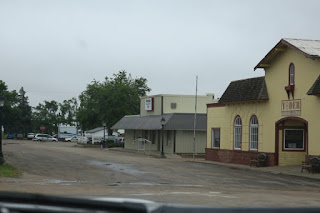Since arriving in Kansas we made two forays into the country. First we went to the Mennonite town of Goessel, (say gossel), to the Mennonite Heritage and Agricultural Museum. The town of Goessel was named after Kurt von Goessel, a heroic German sea captain, in 1895. Today the town has a population of about 535. About 50% of the area residents consider themselves Mennonite.
The Museum is dedicated to telling the stories of a group of Mennonites who immigrated to Kansas from southern Russia in 1874, and to the story of the development of the Central Plains into arable land with an emphasis on wheat production. Six of the buildings are more than 100 years old. All were moved to the museum grounds from area locations and restored.
The museum preserves artifacts from early households, farms and institutions in the Goessel area.
One man carved the village people. The hair is real, donated by area residents.
Very old patchwork with embroidery.
When the immigrants arrived they lived in temporary housing until they could get their barn built and move into part of it. When time allowed then the permanent house was built.
When the people all moved onto their own land, the immigrant barracks were put together to make the church.
Swords into plowshares we understood. Duane wondered about the arrows, I decided that they were wheat.
This stump was petrified in 1874. I checked it out--it really is rock.
The Turkey Red Wheat Palace was built in 1974 in memory of and to honor Mennonites from Russia who brought Turkey Red hard winter wheat to the Kansas prairies and all others who made tilling the soil their life's work. Artifacts include the implements and tools relevant to farming from the mid 1880's through the 1950's. It is the permanent home of the Wheat Straw Liberty Bell. It was created by Mennonites in the Goessel area upon the commission of the Smithsonian Institutions. It was part of the Smithsonian's Bicentennial Exhibit from 1976-1978.
I wondered about this little rv. It is actually a horse-drawn cook shack which followed the thresher as it went from field to field. The cook stood in the doorway to drive the team.
Blacksmith shop
This barn was built as a wedding gift in 1902. The couple lived in the three rooms at one end of the barn until 1910. Their first four children were born here. The flooring in the barn is all wood. At the time the barn was built, it was not unusual for animals and their human caretakers to share a common shelter, with a passage between the two living sections.
Unusual wool yarn design
Woven carpet
Toy design hasn't changed much.
Who are the Mennonites? They trace their roots to the 16th century Anabaptists, who were part of the Protestant Reformation. "Anabaptist" means "rebaptizer", a nickname given to these reformers because their adult baptism followed their earlier baptism as infants. Anabaptists believed in adult believers' baptism, separation of church and state, and rejected participation in war. Other churches that come from the Anabaptist tradition include the Old Order Amish, Hutterites, Church of the Brethren, Brethren in Christ, and Mennonite Brethren. The name Mennonite comes from Menno Simons, a 16th century Dutch Anabaptist leader. You can't tell a Mennonites by their looks. They have no particular way of dress and live just like everyone else, except that they tend to live a bit more simply and economically than most. Now you know.
In the other direction we found the tiny crossroads of Yoder. In 1889 Eli Yoder founded the little town as a central point for surrounding Amish communities. The town is the same size today as when it was built. We went there to shop for home goods. We perused Yoder Meats where you can buy wholesale. We bought homemade cinnamon rolls and toffee.
This is the entire Main St.
Outside town we drove this slippery dirt road to find
the Country Variety Store. This is a little building on a farm. The house is to the right. In here I found fabric called netting for less than I have found it in fabric stores, and in a lot more colors. I also found a couple of nice puzzle books for gkids' bday presents. Who knew? I did, of course! There are all kinds of things in one of these stores that can't be found elsewhere.
There was electric in town to attract tourists. No one lives in town. There is no electric to any of the surrounding farms. The only cars belonged to visitors. We did see a couple of horse-drawn buggies. We saw several of these--small tractors hauling 2-horse trailers.
We have done all of our touring in the truck. The weather has been too windy/rainy/chilly for bike riding, which has been a disappointment to us. The weather calls for rain and highs in the 50's the rest of the week. Oh well.
See ya later,
Louise and Duane





















1 comment:
What an interesting story about the Liberty bell. I bet Duane enjoyed the Blacksmith shop. The wool yarn design is beautiful.
Post a Comment